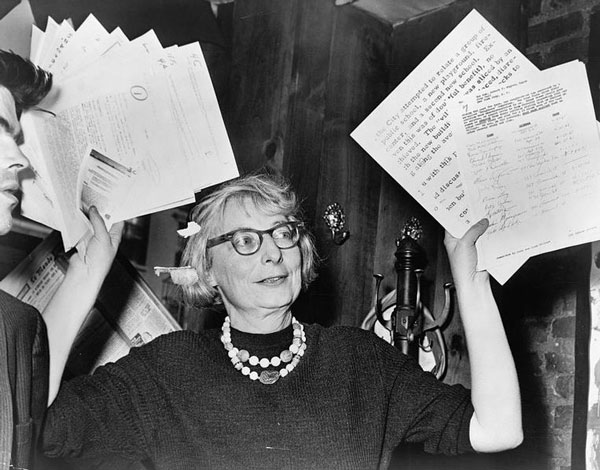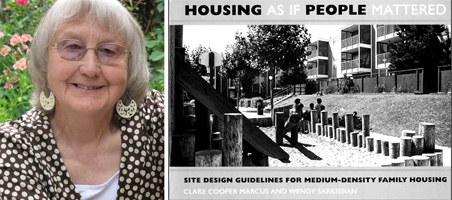Guest Post: VIA Architecture
In recognition and celebration of International Women’s Day last week, we at VIA Architecture polled our team to see which female architects, planners, and designers have made an impact on them. This is who they came up with (in no particular order):
Author of The Death and Life of Great American Cities, a seminal and inspirational book for any urban planner/designer/architect or pretty much anyone who lives and breathes in a city.Jane Jacobs (1916-2006) was an urbanist and activist whose writings championed a fresh, community-based approach to city building. She had no formal training as a planner, and yet her 1961 treatise, The Death and Life of Great American Cities, introduced ground-breaking ideas about how cities function, evolve, and fail that now seem like common sense to generations of architects, planners, politicians, and activists.
Jacobs saw cities as ecosystems that had their own logic and dynamism which would change over time according to how they were used. With a keen eye for detail, she wrote eloquently about sidewalks, parks, retail design, and self-organization. She promoted higher density in cities, short blocks, local economies, and mixed uses. Jacobs helped derail the car-centered approach to urban planning in both New York and Toronto, invigorating neighbourhood activism by helping stop the expansion of expressways and roads. She lived in Greenwich Village for decades, then moved to Toronto in 1968 where she continued her work and writing on urbanism, economies, and social issues until her death in April 2006.

Billie Tsien
Billie Tsien was born in Ithaca, New York. She received her undergraduate degree in Fine Arts from Yale and her Masters in Architecture from UCLA. Billie Tsien has worked with Tod Williams since 1977, and in 1986 they formed the partnership of Tod Williams Billie Tsien Architects in New York City.
Their compelling body of work includes the American Folk Art Museum in New York; the Neurosciences Institute in La Jolla, California; Cranbrook Natatorium in Michigan; Skirkanich Hall at the University of Pennsylvania; a conference center at Bennington College; the Asia Society in Hong Kong; and the Barnes Foundation in Philadelphia. Projects in construction include a performing and visual arts center at the University of Chicago; a dormitory at Haverford College; an information technology campus for Tata Consultancy Services in Mumbai, India; two new skating rinks for Brooklyn’s Prospect Park; the Andlinger Center for Energy and the Environment at Princeton University; and an addition to Savidge Library at the MacDowell Colony. Projects in design include an addition and renovation to the Hood Museum at Dartmouth College as well as the New United States Embassy Compound in Mexico City.

photo credit http://www.mecanoo.nl
Francine Houben
Meccanoo Architects, The Netherlands
Wrote book: Mobility: A Room With a View which analyses traffic corridors around the world and how those can be improved.
“Architecture must appeal to all the senses and is never a (purely) intellectual, conceptual or a visual consideration alone. Architecture is about combining all of the individual elements into a single concept. In the end, what counts is the arrangement of form and emotion. Architecture should touch all the senses.”
– Francine Houben, architect/creative director Mecanoo Architecten.
Always looking for inspiration and the secret of a specific location, Francine bases her work on both analyses and intuition. She enjoys interweaving social, technical, playful, and humane aspects together in order to form a unique solution to each situation. Francine Houben combines the disciplines of architecture, urban planning, and landscape architecture in an non-traditional way; with sensitivity for light and beauty. Her use of material is expressive; she is known as one of the most prolific architects in Europe today. Her wide-ranging portfolio comprises an intimate chapel built on the foundations of a former 19th century chapel in Rotterdam (2001) to Europe’s largest library in Birmingham (2013).

photo credit http://www.graftonarchitects.ie
Yvonne Farrell and Shelley McNamara
Principals at Grafton Architects
Yvonne Farrell and Shelley McNamara graduated from the School of Architecture at University College Dublin in 1974, where they began teaching in 1976. Both lecture and teach internationally. They are also founding members of Group ’91 Architects, winners of the International Competition for the Regeneration of Temple Bar, Dublin. Together, they are co-founders of Grafton Architects established in 1978 in Dublin. The practice has been engaged in the design and building of university buildings, schools, housing, houses, mixed-use buildings, and institutional buildings, together with urban design projects. In 2008 they won World Building of the Year Award at the for Universita Luigi Bocconi in Milan, Italy (also shown above).
photo credit (left) http://www.e1027.org, (right) M. Bougot
Eileen Gray
Neglected for most of her career, Eileen Gray (1878-1976) is now regarded as one of the most important furniture designers and architects of the early 20th century and the most influential woman in those fields. Her work inspired both modernism and Art Deco.
Her design style was as distinctive as her way of working, and Gray developed an opulent, luxuriant take on the geometric forms and industrially produced materials used by the International Style designers, such as Le Corbusier, Charlotte Perriand, and Mies Van Der Rohe, who shared many of her ideals. Her voluptuous leather and tubular steel Bibendum Chair and clinically chic E-1027 glass and tubular steel table are now as familiar as icons of the International Style as Le Corbusier and Perriand’s classic Grand Confort club chairs, yet for most of her career she was relegated to obscurity by the same proud singularity that makes her work so prized today.

photo credit (left) Chester Higgins Jr./The New York Times, (middle) Ola Robbins, (right) Wave Field, University of Michigan, Ann Arbor
Maya Lin
Trained as an artist and architect, Maya is best known for her large, minimalist sculptures and monuments. When she was only 21 and still a student, Lin created the winning design for the Vietnam Veterans Memorial in Washington, D.C.
Her most famous buildings have political and aesthetic motivations that elicit strong emotions in people, partly based on how they encapsulate their age. Maya unexpectedly won the design competition for the Vietnam Veterans Memorial while a Yale student, and it threw her into a huge storm of controversy. The controversy over Maya Lin’s design showed the raw emotional wounds that still had not healed when it erupted in 1980, and Maya Lin’s finished memorial showed the power of art to affect people and touch upon important issues of society.
photo credit Inhabitat
Michelle Kaufmann
In Prefab Green, architect Michelle Kaufmann shares her vision of creating thoughtful, sustainable design for everyone. Her work blends sustainable home layouts, eco-friendly materials, and low-energy options to create a “prepackaged” green solution to home design. Kaufmann tells about five eco-principles that are present in every design her firm creates–smart design, eco-materials, energy efficiency, water conservation, and healthy environment–and how each work together to create homes that make a difference.
Clare Cooper Marcus
Clare Cooper Marcus is Professor Emeritus in the Departments of Architecture and Landscape Architecture at the University of California, Berkeley. She is internationally recognized for her pioneering research on the psychological and sociological aspects of architecture, land-use planning, and landscape design – particularly urban open space.
One of her many books on the subject, People Places, is considered a Gold Standard for Plaza and Public Space design.

photo credit (left) Jeff J Mitchell ©2011 Getty Images, (right) Hufton + Crow
Zaha Hadid
Born in Baghdad, Iraq in 1950, Zaha Hadid was the first woman to win a Pritzker Architecture Prize. Her work experiments with new spatial concepts and encompasses all fields of design, ranging from urban spaces to products and furniture.
***
Did you know?
International Women’s Day is now an official holiday in Afghanistan, Armenia, Azerbaijan, Belarus, Burkina Faso, Cambodia, China (for women only), Cuba, Georgia, Guinea-Bissau, Eritrea, Kazakhstan, Kyrgyzstan, Laos, Madagascar (for women only), Moldova, Mongolia, Montenegro, Nepal (for women only), Russia, Tajikistan, Turkmenistan, Uganda, Ukraine, Uzbekistan, Vietnam, and Zambia. The tradition sees men honoring their mothers, wives, girlfriends, colleagues, etc. with flowers and small gifts. In some countries IWD has the equivalent status of Mother’s Day, where children give small presents to their mothers and grandmothers. For more information on IWD, visit www.internationalwomensday.com.
**
We also invite you to visit the VIA Architecture blog for our regular posts.








One comment
Janette Sadik-Khan!